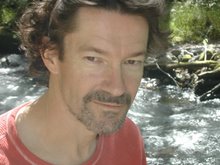While washing the dishes this morning after a frenetic Bahrain Grand Prix (what possesses people to live in a giant sandpit?) I took opportunity to catch up on some podcasts from NPR's Science Friday. Despite Ira Playdough's slightly irritating voice, the program's are usually informative and interesting. This one discussed the future of algae as a source of fuel and food. Some of my own students have been attempting to grow the blighters in order to extract oil to convert into biodiesel. This has proved somewhat more challenging than originally envisaged. While the potential is there, I suspect that the quantities of algae required to replace a significant fraction of the fossil fuel consumption are mind-bogglingly enormous, which translates into the areas of water required to culture them equally daunting. Nonetheless, research into algae is proceeding at a pace as frenetic as that of Jenson Button in his (third) winning drive.
One of the guests on the show was the director/curator of perhaps the largest library of algae in the United States, which is housed at the University of Texas, Austin. I discovered this self-same institution when roaming the internet in search of a source of Chlorella for the students to culture. We have since purchased a number of different strains from UTEX, which possesses a dizzying array of these things. Like any good library, the history of each strain is painstakingly documented; some of them can be traced back decades. Papers published using the strain are faithfully noted. For the neophyte like myself, making a purchase is a bit like throwing a dice.
One of the things we have discovered with algae, and I suspect some of these companies interested in turning them into energy sources have also discovered, is that they aren't as easy to grow as you might think. After all, you find them floating in and on all kinds of unpleasant, unsanitary looking bodies of water; but in the laboratory they are a lot more finicky, or so it seems. Media have to be just so; each strain comes with a recommended medium for its growth. Sterilization is also essential - a bit like home-brewing beer (an activity that the SSCP is poised to undertake but is yet to bite the bullet - fear of failure holding him back). A lot of the time we have ended up with some exotic but thoroughly disgusting concoction of multi-colored slimes, liberally adorned with all sorts of foreign molds (moulds? I never can remember. Doubtless Dulcie will gladly point out any error.
Scienceblogs is shutting down
8 years ago





1 comment:
Back in November, 2008, I watched a "green" special on CNN. The first segment was on growing algae for biofuel. Here's a link to the transcript: http://transcripts.cnn.com/TRANSCRIPTS/0811/23/se.01.html
Unfortunately, there are no pictures with the transcript--the culturing is all done in a series of relatively thin, vertically-oriented panels in the desert outside El Paso, TX. I was impressed by the relatively small volume of water and small footprint they could achieve with the vertical, flow-through process. The company's name is Vertigro.
dwk001
Post a Comment